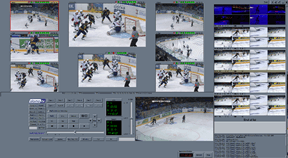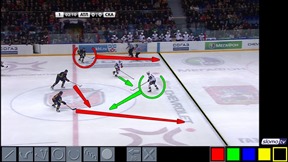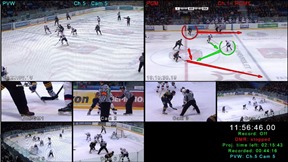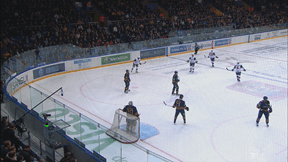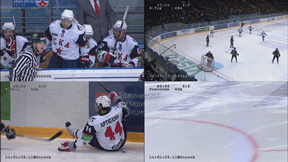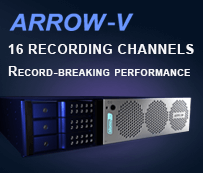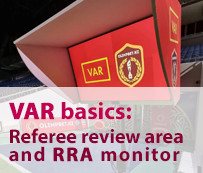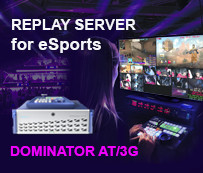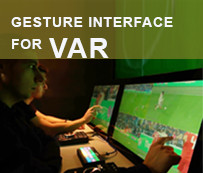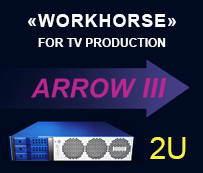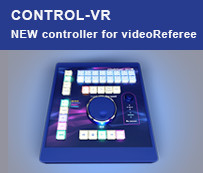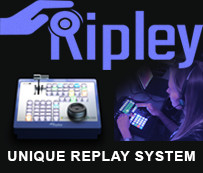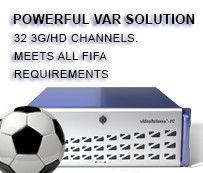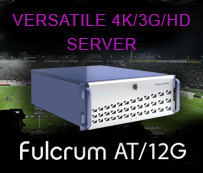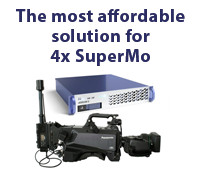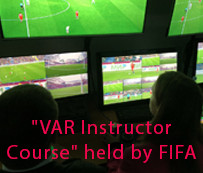At all times, the sports judges felt the need for a reliable tool that would allow them to make an absolutely correct decision, dictated by the rules of the competition, fairness, logic and game situations. Eyesight, measuring tape and a stopwatch for a long time were the only assistants. But progress does not stand still and to the aid came photo-finish. For a long time it was the only complex technical means to determine the winner in various sports. But photo finish cannot be used in team sports. And using it is hardly convenient. However the idea of filming to make an objective decision was interesting and productive.
So it was only natural that video-recording became the tool for analysis of controversial issues. The process of rendering decisions based on the video and all the technical aspects associated with it became known as sports video judging.
There is no doubt that using video is more convenient than using movie cameras. No need for film processing. A logical step in technological progress of video judging systems would constitute the appearance of a system that could be easily controlled by the judges themselves without the help of technical personnel.
Slomo.tv combined its multichannel recording and instant replay system with scoreboard data integration and developed a revolutionary interface which became an etalon in sport video judging. It is still the de facto standard in the industry.
Multi-channel recording, simultaneous search on all or a single channel, synchronization of all cameras, the ability to mark events, a simple and user-friendly interface, and controls similar to CD player – all this created a very convenient and simple working environment for officiating judges.
In 2007 slomo.tv revolutionized technology, philosophy, and itself the object of video judging releasing the world's first videoReferee® system. The system was first used at the ice hockey world championship held in Moscow.
Let's trace the evolution of video judging systems and how slomo.tv innovations radically changed the decision-making in team sports controversial moments.
Photo-finish
The first video judging decision was photo-finish system used at the races. The price of an error in racing in the literal sense is very high. Subsequently, the photo finish has been applied to determine the order of crossing the finish line by competitors. Shooting was carried out by high speed film cameras with continuous film movement and a shutter slit which allows recording of the image stretched in the space.
The modern photo-finish systems use the same principle of shooting with a slit fixing a line of only one pixel wide and combining all such strips into a video frames. Unlike conventional cameras, these special CCD digital cameras record only one vertical row of matrix pixels. The imaging speed can be up to 10,000 lines per second, while the most common systems provide up to 2000 lines per second. The resulting data are transmitted to a computer, where with the help of specialized software it is presented as one continuous image of the finish line during the active capture time. The photo-finish judge determines the crossing order.
An important feature here is the working height of the matrix, which determines the length of the finish line covered by the photo finish camera. The wide finishing lines (e.g. in rowing and some other sports) require a maximum capture width. If the capture width of existing systems is not enough - it is necessary to use multiple cameras for each section of the finish line.
Ice Hockey
Any innovative technology can be applied to where there is demand and there is money. Video judging was no exception to this rule. The next stage in the evolution of technical systems for on-the-fly analysis of controversial moments was connected with the appearance of large budgets in various sports, and as a consequence, the high price of judging mistake. The first sport in which all these factors came together was ice hockey.
The most disputes before introduction of video judging were connected with scoring.
The high speed of the puck (130-150 km/h) and use in broadcasts slow motion replays from multiple cameras contributed to the idea and ideology behind the prototype of the first systems determining the fact of the goal. Such systems were called "Video-Goal".
In order to legitimize decisions obtained using video it was necessary to make the appropriate changes in the regulations that would govern:
- The situations in which you need to use the system;
- Procedure of analyzing dispute;
- Minimum equipment requirements.
The first video judging system in hockey worked with four cameras, video of which was used in the analysis of a goal. It usually consisted of four video recorders. Sometimes an expensive replay system and video mixer were used. In the dispute the referee directed the video engineer who ran the system to select the desired camera, searching for the right moment and perform frame by frame analysis. It was terribly inconvenient and took a lot of time searching for the right fragment. Such systems were far from perfect.
The Breakthrough
In 2007 the World Hockey Championship was held in Moscow. According to regulations of the International Ice Hockey Federation (IIHF) the host broadcaster is responsible for video judging. As a back-up solution they chose the slomo.tv 4-channel replay system Fulcrum.
During installation, slomo.tv engineers with close with Vladimir Mironov, the chief engineer of Krylatskoye Ice Arenas, developed the concept of a modern video judging system for ice hockey and in the shortest possible time created the software implementing this concept.
In the course of the championship it became clear that we came up with the right solution. It turned out that it was easier for referees to use the "backup system" by themselves than every time explain to the broadcast engineer what and how should be shown.
Basic principles of the slomo.tv video judging system
- Scoreboard information should always be recorded and be displayed when watching video. This is very important because, in accordance with the rules a goal counts only when it happens before the time has been stopped. Therefore having full synchronization of video cameras with the scoreboard controller data becomes mandatory;
- All recorded video tracks must be synchronized at any given time, even in the presence of asynchronous cameras. This is necessary to ensure that you are viewing the desired frame regardless of selected channel;
- The ability to view live video and the ability to view video from several cameras simultaneously;
- Ability to get the full game information - current score, period, elapsed and remaining time until the end of the period;
- Ability to search for a needed fragment on one or several channels simultaneously;
- Simple and accessible interface that could be quickly mastered even by a layman;
- Availability of export to DVD a video report for possible post-game refereeing claims.
The new system was named videoReferee®.
From the outset it could support two workplaces, each with a video monitor and remote controller, allowing the operator/judge to analyze in detail all points of contention, bookmark video and observe in real-time the action on the field with four cameras simultaneously.
Referee's workplace can be located away from the server (the current record is 3km).
The system capabilities fully satisfied all requirements of IIHF and NHL. That is why 2007 can be considered the birth year of the modern video judging systems.
Six recording channels
Analysis of game situations showed that two camera arrangement with one over the coal and the other on the glass barrier behind the goal could not always give a clear idea of whether the puck crossed the goal line. It became apparent that having a view of the goal line from inside the goal would greatly help referees decision making. So system designers decided to increase the number of recording channels from 4 to 6 with 1 wireless camera inside each goal.
Thus, in 2008 the classical video judging system with three cameras at each goal, videoReferee®-6 SDI , was formed. It provided synchronous recording of all channels, capturing of scoreboard data and a DVD video report. Later, a zooming feature for more accurate visual inspection was introduced.
Panoramic camera
After listening to the wishes of the referees, who wanted to keep track of not only the score moments, but also preceding situations like icing, offside and fouls, slomo.tv in close cooperation with Kontinental Hockey League (KHL) added panoramic recording.
It turned out that when panoramic camera records in standard definition the puck simply could not be visible. At resolution of 720 pixels for the 60 m side of the rink the 8 cm puck accounted just for one pixel of the image. Therefore it became necessary to add to the videoReferee® one HD-SDI video input for Full HD panoramic camera. By the way, this configuration is now a requirement for VHL.
As was already mentioned, the striking speed of the puck reaches 40-45 m/s. At this speed and shooting at 25 frames per second, the puck in the frame picture looks like "sausage". At low exposures puck is fixed at the moment shutter release, and the puck can only be seen in only one position, which may not coincide with the point of crossing the goal line. As a result, it is impossible to trace at what point of time the puck went into the goal – before or after the time was stopped. And in some cases it is impossible to say whether it ever crossed the line. Carefully analyzing the situation, slomo.tv developers introduced a search mode based on frame fields, which doubled the number of phases. Special DSP algorithm for video processing allows to select the puck position at high speeds of its movement. In addition, it was recommended to shoot at higher shutter speeds, so the point of crossing the goal line could be visually tracked, instead of just seeing its discrete position.
Broadcast quality and integration with television broadcast equipment
Hockey referees always judge fairly. It is a fact. Yes, the referee can miss something or see only part of the event. A referee may be tired. The referees are human and emotional stress, coupled with physical exertion (unlike the players they are not resting on the bench) can lead to a "blurring" vision. But all these are external factors. And that is why they are most interested fair resolution of disputed moments. A high image quality helps to achieve this. It is obvious that in 1920x1080 resolution the judge is able to analyze the situation more detailed. Another aspect of high quality of the video is the ability to incorporate the picture from video judging system into the broadcast. This allows the director to include "suspenseful moments" in the broadcast. For example, a picture from videoReferee® allows to quickly discuss a game situation using telestrator (Game Analyzer). All this as well as half-time analysis by experts of information received from video judging cameras, provides additional incentives for keeping the viewer at the TV screen.
Using six or more cameras, two of which are inside the goals, and two are high on the arena ceiling over the goal allow the director to show the game from a variety of angles and make a more attractive broadcast. In addition, it is also an opportunity to save on additional equipment. The OB Van can show replays not only from their cameras, but also from videoReferee® cameras with unusual camera angles and make the viewer a participant in resolving disputes.
Presently all videoReferee® systems not only work with Full HD, but can control settings of slomo.tv cameras. Remote control via Ethernet of camera zoom, focus, iris, shutter speed, sensitivity, white balance and color balance is carried out directly from the server. Using separate standalone software these cameras can be included in television setup. Such features are only available on professional TV cameras, the cost of which is much higher than the cost of slomo.tv vR-Cam.
Another aspect of television and video judging convergence is the ability to use in the television broadcast the material recorded by videoReferee®. And here again slomo.tv offered a convenient and cost-effective solution - Direct Connect option. This option allows the replay server to access video judging recorded material via standard 1GbE network.
11 recording channels
There are situations when the information from the cameras controlling the area of the goals and panoramic camera is not enough to make the right decision in a dispute. For example, a goal was hammered with a high stick outside the view of installed cameras. To confidently resolve similar situations we increased the number of recording channels 11 and proposed installation of four additional cameras on both sides of the rink to maximize the viewing area controlled by referees. The 11-channel system called videoReferee®-IIM2 became available in 2010 and was first implemented at "Megasport" arena in Khanty-Mansiysk for the HC "Yugra". It works with 11 HD or SD cameras in any combination and is still the most widely used system in ice hockey.
VideoReferee®-IIM2 is designed for continuous recording with professional quality (MJPEG 150Mbps) of 11 channels in sync with the official scoreboard data. The system provides recording, search and playback at the same time. It provides for manual creation of marks and also automatically creates event marks using intelligent algorithms for controlling game information. There is mechanism for navigation between marks and real-time live mode for viewing one or any set of 4 cameras, which allow the operator continuously monitor the game. There is also a frame zoom mode. The system allows production of video reports in SD resolution on DVD, as well as MPEG Long GOP files with Full HD resolution.
A standard computer monitor with Full HD resolution is used as display. The system comes with a special controller for handling camera selection and other functions.
System setup is done via engineering interface, which uses the system monitor usually located near the server. Currently we support all major types of scoreboard controllers (Nautronic, Westerstrand, Megalux, Omega, and other.). A feature of the system is a semi-automatic creation of video report based on created marks. It includes selected events and official game information (time, score and period).



